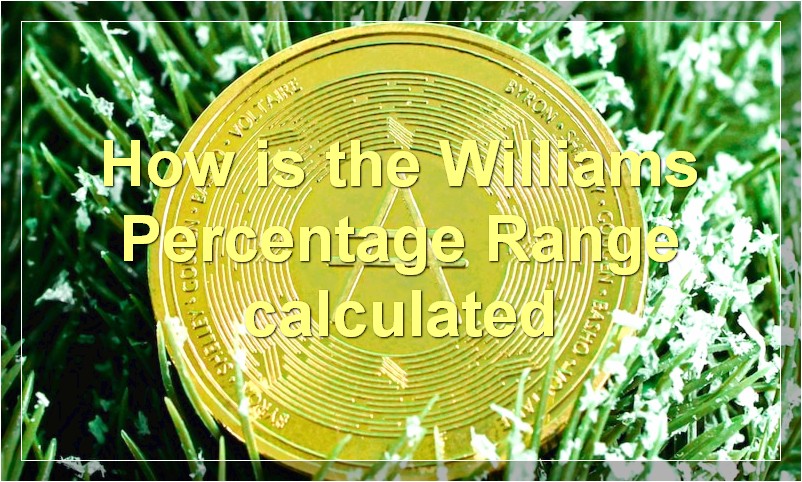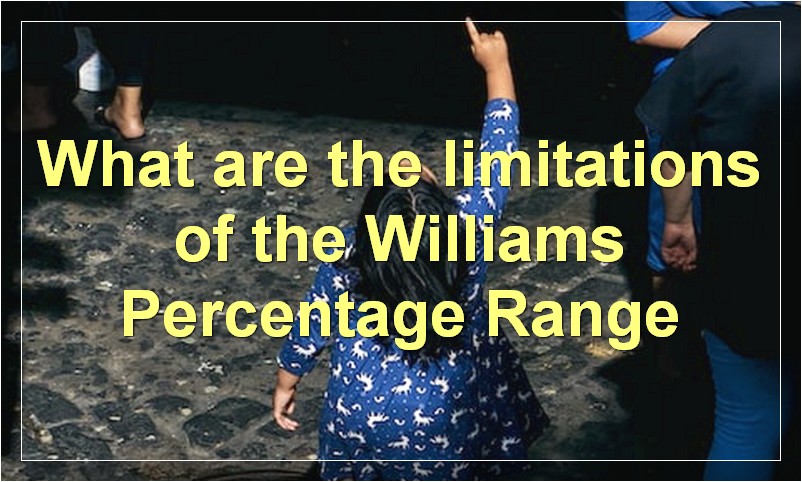If you’re looking to get ahead in the world of investing, it’s important to know about the Williams Percentage Range. This powerful tool can help you make sense of market movements and find opportunities for profit.
What is the Williams Percentage Range
There are a lot of different indicators that traders use to try and predict where the markets are headed next. Some use Fibonacci levels, some use moving averages, and some use the Williams Percentage Range.
The Williams Percentage Range is a momentum indicator that ranges from 0 to -100. It is calculated by taking the difference between the highest price of the day and the close price, and then dividing it by the highest price of the day. If the resulting number is less than 0, it is multiplied by 100 to get the percentage range.
The Williams Percentage Range is used to identify overbought and oversold conditions in the market. A reading above -20 is considered overbought, and a reading below -80 is considered oversold.
Traders often look for divergences between the Williams Percentage Range and price to predict future price movements. A divergence occurs when the indicator is making new highs or lows while price is stagnating or moving in the opposite direction. This often signals a reversal in the market.
The Williams Percentage Range can be a useful tool for traders who know how to use it properly. However, like all indicators, it should not be used alone but rather in conjunction with other technical analysis tools.
How is the Williams Percentage Range calculated

The Williams Percentage Range, or Williams %R, is a momentum indicator that measures overbought and oversold levels. It is calculated using the following formula:
Williams %R = (Highest High – Close) / (Highest High – Lowest Low) * -100
The indicator ranges from 0 to -100, with readings below -80 considered oversold and readings above -20 considered overbought.
What is the significance of the Williams Percentage Range
The Williams Percentage Range is a technical indicator that measures overbought and oversold levels in a market. It is calculated by taking the highest high and lowest low of a given period and dividing it by the closing price. The Williams %R can be applied to any market, but is most commonly used in stocks and commodities.
The Williams %R is a momentum oscillator that ranges between 0 and -100. A reading of -100 indicates that the security is oversold, while a reading of 0 indicates that it is overbought. readings below -80 are considered to be in oversold territory, while readings above -20 are considered to be in overbought territory. The Williams %R is a lagging indicator, meaning that it will usually confirm trends that have already been established.
The Williams %R is a useful tool for identifying potential turning points in a market. However, like all technical indicators, it should not be used as a standalone tool and should be combined with other forms of analysis before making any trading decisions.
What are the benefits of using the Williams Percentage Range
The Williams Percentage Range is a technical indicator that is used to measure overbought and oversold conditions in the market. The indicator is calculated by taking the highest high of the past n periods and subtracting the lowest low of the past n periods. This value is then plotted as a line on a chart with a range of 0 to -100.
The Williams Percentage Range is a valuable tool for traders because it can help them identify market reversals and potential trading opportunities. The indicator is most useful when it is used in conjunction with other technical indicators.
How can the Williams Percentage Range be used to improve trading strategies
The Williams Percentage Range is a technical indicator that measures overbought and oversold conditions in the market. It is based on a simple concept: if the market is overbought, prices will fall, and if the market is oversold, prices will rise.
The Williams Percentage Range is calculated using the following formula:
Williams %R = (Highest High – Close) / (Highest High – Lowest Low) * 100
The Williams %R ranges from 0 to -100. A reading of -100 indicates that the market is oversold, while a reading of 0 indicates that the market is overbought.
The Williams %R can be used to improve trading strategies in a few ways. First, it can be used to identify entry and exit points in the market. Second, it can be used to time the market. For example, if the Williams %R is indicating that the market is oversold, a trader might buy in anticipation of a rally. Conversely, if the Williams %R is indicating that the market is overbought, a trader might sell in anticipation of a pullback.
Third, the Williams %R can be used as a trend-following indicator. For example, if the Williams %R is below -80 for an extended period of time, it might be indicative of a long-term downtrend. Conversely, if the Williams %R is above -20 for an extended period of time, it might be indicative of a long-term uptrend.
Fourth, the Williams %R can be used as a momentum indicator. For example, if the Williams %R is making new lows while prices are rallying, it might be indicative of strong bullish momentum. Conversely, if the Williams %R is making new highs while prices are falling, it might be indicative of strong bearish momentum.
Finally, the Williams %R can be used to confirm other technical indicators. For example, if the Williams %R is indicating that the market is overbought and the Relative Strength Index (RSI) is also indicating that the market is overbought, it might be confirmation that prices are likely to fall.
What are the limitations of the Williams Percentage Range

The Williams Percentage Range is a technical indicator that is used to measure overbought and oversold conditions in the market. It is created by Larry Williams and is calculated by taking the highest high of the past N days and subtracting it from the lowest low of the past N days, where N is the number of days used in the calculation. The indicator ranges from 0 to -100, with readings above -20 indicating overbought conditions and readings below -80 indicating oversold conditions.
While the Williams Percentage Range is a useful indicator, it does have some limitations. First, it is a lagging indicator, meaning that it will only tell you what has happened in the past and not what is happening in the present or future. Second, it is not well suited for use in range-bound markets, as it will often give false signals during these periods. Finally, because it is a momentum-based indicator, it is subject to whipsaws, which are false signals that occur when prices move quickly in one direction and then reverse course just as quickly.
How does the Williams Percentage Range compare to other technical indicators
The Williams Percentage Range is a technical indicator that is used to measure overbought and oversold levels in the market. It is similar to other indicators such as the Relative Strength Index (RSI) and the Stochastic Oscillator.
The Williams Percentage Range is calculated by taking the highest high of the past N days and subtracting the lowest low of the past N days. The resulting number is then divided by the highest high of the past N days and multiplied by 100.
The Williams Percentage Range is a valuable tool for traders because it can help them identify when a market is overbought or oversold. It can also be used to find potential support and resistance levels.
What are some common misconceptions about the Williams Percentage Range
There are a few common misconceptions about the Williams Percentage Range. One is that it only applies to stocks. This is not the case, as the Williams Percentage Range can be used for any asset, including commodities and Forex.
Another misconception is that the Williams Percentage Range is a leading indicator. While it can be used to predict future price movements, it is not a perfect indicator and should be used in conjunction with other indicators.
Lastly, some people believe that the Williams Percentage Range is too complicated to use. While it does take some time to learn how to use it effectively, it is not overly complicated and can be a useful tool for traders of all levels of experience.
What are some ways to interpret the Williams Percentage Range
There are a few ways to interpret the Williams Percentage Range. One way is to use it as a measure of how overbought or oversold a stock is. A stock is considered overbought when the Williams %R is below -20, and oversold when the Williams %R is above -80.
Another way to interpret the Williams %R is to use it as a buy or sell signal. A buy signal occurs when the Williams %R crosses above -50, and a sell signal occurs when the Williams %R crosses below -50.
Finally, some traders use the Williams %R as a trend-following indicator. They will buy when the Williams %R is below -80 and start to turn up, and sell when the Williams %R is above -20 and start to turn down.
What are some potential pitfalls when using the Williams Percentage Range
There are a few potential pitfalls when using the Williams Percentage Range. First, the indicator only works well in trending markets. Second, the indicator can produce false signals in choppy markets. Third, the indicator is lagging, so it’s not useful for making decisions in real-time.

